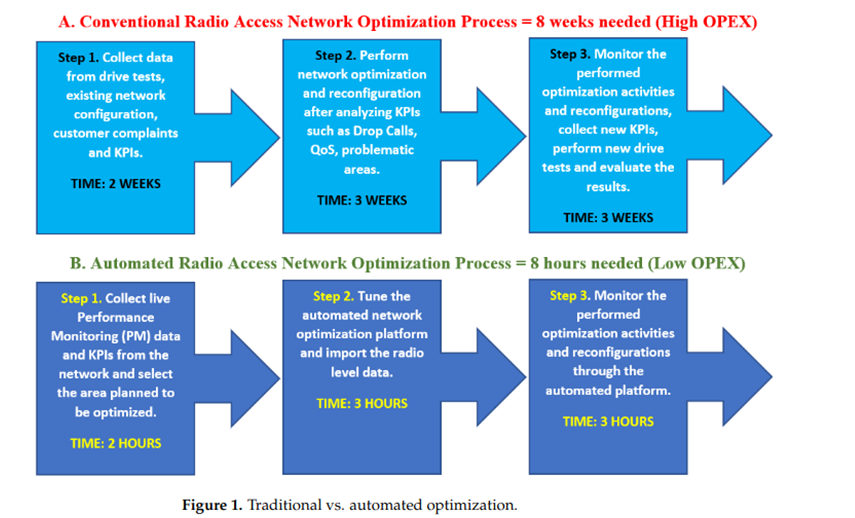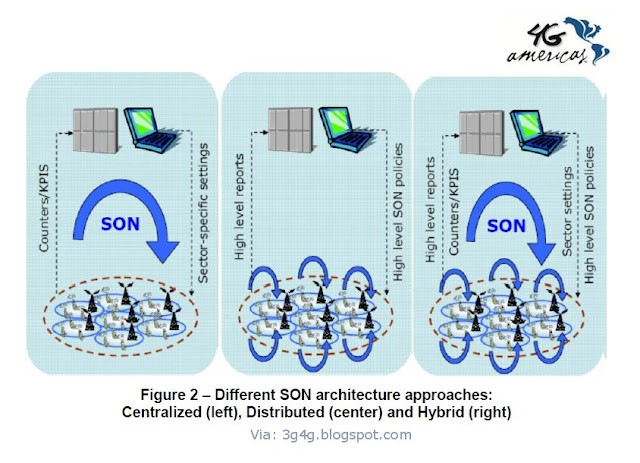Self-Organizing Networks (SON) have the potential to rapidly and simultaneously transform network economics and improve customer experience. Two variants of SON — Centralized and Decentralized — focus on different approaches. Network operators need to be aware of their capabilities and consider where each provides the best optimization support.
SON Systems automate the configuration and optimization of wireless networks to help operators maximize deployed RF and spectrum capacity, simplify Radio Access Network (RAN) management and improve customer experience, all while reducing network OPEX. Complexity and costs associated with network management have been steadily increasing for several years as the number of network parameters to be monitored and 'tuned' has grown exponentially both for the Radio Network Controllers (RNC)/Base stations in 3G networks and for the eNobeB/MME in LTE/4G networks.
Especially considering the RAN optimization aspect, which is our focus, the following figure depicts the comparison of traditional, legacy(manual) approach compared to automated optimization through SON. The benefits as shown in the Fig 1. are important since the conventional RAN optimization process takes approximately 8 weeks, which is slower than the automated approach.

According to 3GPP and NGMN, SON use cases are classified into three basic categories. The three basic ones and key pillars are:
1. Self-Optimization
2. Self-Configuration
3. Self-Healing
Self-optimization capabilities include optimization of coverage, capacity, handover, and interference. Load balancing is part of the self-optimization functionality, enabling SON systems to identify cells that are experiencing congestion and transfer the traffic load to other cells that have bandwidth. Coverage and capacity optimization enable scheduled correction of bottlenecks in dynamic environments both daily and seasonally.
Self-configuration enables auto-connectivity and automated initial parameter configuration. Self-configuration based on Automatic Neighbor Relation (ANR) is one of the most deployed SON feature among network operators.
Finally, self-healing capabilities enable automatic detection and removal of failures such as cell outage. In terms of SON system architectures, the 3GPP consortium defines the following three types of SON architectures that can be applied in 2G/3G/4G and 5G networks
1. C-SON(Centralized Self Organizing Network )
2. D-SON(Distributed Self Organizing Network)
3. H-SON(Hybrid Self Organizing Network)

In a centralized architecture, SON algorithms for one or more use cases reside on the Element Management System (EMS) or a separate SON server that manages the eNB's. The values of particular parameters, which are the output of the SON algorithms, are subsequently sent to the eNBs either periodically or as needed. The SON algorithms can be implemented in a more controllable way using a centralized strategy. Before changing SON parameters, it enables use case interactions between SON algorithms to be taken into account. However, because KPIs and UE measurement data must be sent to a centralized location for processing, active updates to the use case parameters are delayed. To maintain the solution's scalability in terms of the volume of information transported, filtered and compressed information is passed from the eNB to the centralized SON server. Compared to the eNB, the SON server has less information available. The use of a purely centralized SON architecture is limited to those algorithms that require slower response times due to higher latency caused by the time needed to collect UE information. Additionally, because the centralised SON server is a single point of failure, an outage in the server or backhaul could cause the eNB to use stale and outdated parameters because the eNB is probably less likely to update its SON parameters on a regular basis than is possible with a distributed solution.
SON algorithms are housed within eNBs in a distributed approach, enabling autonomous decision-making at the eNBs based on UE measurements received on the eNBs and additional information from other eNBs being received via the X2 interface. A distributed architecture enables faster optimization and simple deployment in networks with multiple vendors. Various times of the day could be optimized for. However, careful KPI monitoring is required to prevent potential network instabilities and guarantee overall optimal operation because it is impossible to guarantee standard and identical algorithm implementation in a multi-vendor network.
These architecture options could coexist for various purposes in practical deployments and are not mutually exclusive, as is realised in a hybrid SON approach. A hybrid approach involves running some of a given SON optimization algorithm in the NMS while also possibly running other portions of the same SON algorithm in the eNB. For instance, the initial parameter values could be set up on a central server, and the eNBs could update and fine-tune those parameters in response to the actual UE measurements. Each implementation has pros and cons of its own. Depending on the availability of information, each use case must determine whether to use a centralised, distributed, or hybrid architecture. The use case's processing and response time requirements. For a hybrid or centralised solution, a specific partnership between the infrastructure vendor, the operator, and possibly a third party tool company would be needed for a practical deployment. Depending on how the infrastructure is currently deployed, operators can select the best course of action.
Source: https://www.linkedin.com/pulse/self-organizing-networks-5g-beyond-ak-shaw/

